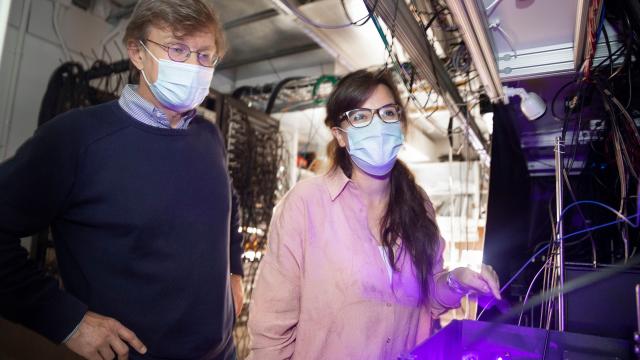A team of researchers has observed a never-before-seen state of matter called a quantum spin liquid by toying with the spins on supercooled rubidium atoms using a quantum simulator. The discovery has implications for the way quantum computers work and, perhaps someday, the environments in which materials can be superconducting.
There are plenty of states (also known as phases) of matter to discover beyond the traditional solid, liquid, and gas from Chemistry 101. The state of something refers to its structure on an atomic level and its properties — for example, how rigid its molecular structures are or how its electrons are arranged about the atomic nucleus.
The existence of a particular state of matter, called a quantum spin liquid, was predicted in 1973 by the late Philip W. Anderson and has been studied ever since. But research into the state was laden with caveats: “emerging,” “proximate,” and “candidate” quantum spin liquids abounded. The recent team — a group of scientists from Harvard University, MIT, and the University of Innsbruck in Austria — say they’ve found an instance of the real thing and have published their observations in the journal Science.
“When P. W. Anderson first proposed the idea of these spin liquid states, he was exactly looking for a possible microscopic model to explain high-temperature superconductors,” Giulia Semeghini, lead author of the paper and a quantum physicist at Harvard, told Gizmodo in an email. While the connection between quantum spin liquids and warm superconductors remains unclear, now such a microscopic model has been developed.
To find the state of matter, the team used something called a quantum simulator to mimic the physics that happen in solids down to the atomic level. The simulator uses geometric shapes to represent the orientation of 219 rubidium atoms in a lattice, which the team were then able to manipulate however they wanted. (The machine is called a quantum simulator because it is not quite a quantum computer; it is a system of quantum bits set up to investigate a specific problem.)
“It is a very special moment in the field,” said Mikhail Lukin, a physicist at Harvard University and a co-author of the paper, in a university press release. “You can really touch, poke, and prod at this exotic state and manipulate it to understand its properties… It’s a new state of matter that people have never been able to observe.”
The quantum state is not liquid in the way you might think; the atoms the team studied weren’t sloshing around, per se. Rather, the rubidium’s electron spins were wishy-washy and never in agreement.
Constantly conflicting and changing electron spins render metals in a quantum spin liquid state “frustrated,” in the parlance of the scientists, as they can’t align how they’re inclined. Quantum spin liquids are among the most entangled quantum states, and the more entangled a system is, the more robust it is — meaning the quantum computer is less likely to fall out of superposition.
“Indeed, the engineered state seems to demonstrate key properties of quantum entanglement in a QSL, which is remarkable!!!” wrote Robert McQueeney, physicist at Iowa State University and Ames Laboratory, in an email. “The potential future work that will inevitably follow is even more exciting, since the cold atom approach is highly adaptable and tunable.”
When things get cold enough, condensed matter (solids) become pretty orderly. It’s that order that makes superconducting systems so useful for precise science experiments, from tracking the collisions of supermassive black holes to forcing electrons into high-powered laser beams to study the smallest structures we know. But when cooled to just above absolute zero, the electrons of the rubidium atoms rejected that order by existing in a state of constant flux, even at such low temperatures: They became a quantum spin liquid.
Computer bits are by definition binary, meaning that they’re either on or off (1 or 0, in binary speak). Quantum computers instead use qubits, which rely on the principle of superposition, meaning they can be treated as both on and off at the same time, allowing the computer to pursue a multitude of solutions simultaneously.
“The great promise of quantum spin liquids is that they can be used to realise robust qubits for quantum computers,” Semeghini said. “The typical way to encode a qubit is in fact pretty fragile to external noise and perturbations. Encoding quantum information in a topological qubit, using different topological states of a quantum spin liquid, gives rise to a qubit that is intrinsically resistant to noise.”
If the first, most reliable direction to take this research is making more robust qubits and as a result more efficient quantum computers, the holy grail would be room-temperature superconductors. They’re what Anderson, who dreamt up quantum spin liquids, was trying to work toward, and they have been an ambition of physics (and the energy industry) since the power of superconductivity was realised. Among other things, removing resistance from electric circuits at room temperature would revolutionise the electric grid as we know it because there wouldn’t be any energy lost to heat. It would also mean advancements wherever superconducting magnets are currently necessary: in medical technologies like MRI machines, particle accelerators, and in super-fast levitating trains. But there’s a long way to go before realising that dream.
As to whether quantum spin liquids can help address room-temperature superconductivity, Semeghini said that “Our experiment does not directly answer this question, but it’s possible that continuing to do research on these types of exotic phases might help understand better the origin of high-temperature superconductivity.”
